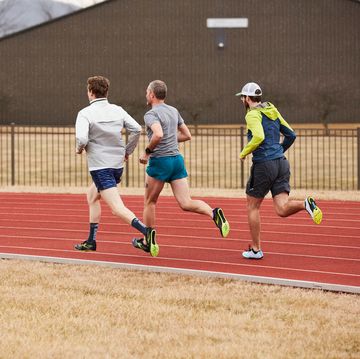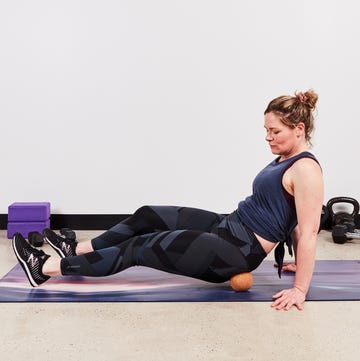Probably the easiest way to tackle speedwork is to ramp up the pace when you feel good and slow down when you need a break. This classic workout strategy, called fartlek (Swedish for "speed play"), alternates easy and hard running–you decide how long and how fast–and is used by both newcomers and Olympic-caliber athletes. For new runners, the flexibility makes fartlek runs an ideal introduction to speedwork. "Fartleks allow the body to gradually adjust to harder training without being forced to stick to a particular pace or distance," says Alan Culpepper, a two-time U.S. Olympian and running coach at culpeppercoaching.com. "The heart works harder, as do the specific running muscles, but because you're in control, it allows for an easier adaptation." For seasoned runners, freelancing a tough workout provides respite from the grind of hitting splits and a chance to tune into how an effort feels (rather than how it looks on a watch). Whatever your goals, injecting a little playtime into your running routine can help you hit your target.
Goal: Run your first race
For your first event, your primary aim should be simply to finish–after all, it's a guaranteed personal record. That said, working a few fartleks into your training will go a long way in boosting your fitness and your confidence when it's time to toe the starting line. "For beginners, the biggest benefit in doing them is not locking into a single pace," says Alan Versaw, a 14-time state champion coach at The Classical Academy in Colorado Springs. Time spent running fast develops a stronger cardiovascular system, improves stamina, and teaches your body to run more efficiently.
Playtime: Run the "100 Steps Fartlek." Warm up with a 10-minute jog. Pick up the pace for 10 strides (counted on one leg), then run slowly for 10 strides. Run hard for 20 strides, then recover with 20 strides. Work your way up in 10-stride, alternating increments until you're feeling winded or hit 100 strides, whichever comes first. Once you've mastered making it to 100 steps, increase the challenge by going back down in 10-step increments or by increasing the pace. Finish with a five-minute jog to cool down. Do once every two to three weeks.
Goal: Nail a PR
Training for a time target takes both a physical and mental toll. Substituting the occasional speed session with a fartlek run releases you from the chore of hitting splits. "You can get in a good workout without fretting too much about your pace–and get a little psychological rebound," says Jennifer Michel, the head cross-country coach at Western State in Gunnison, Colorado. Fartleks also allow you to practice running by feel, which is critical when hills or weather conditions prevent you from clicking off a perfectly paced race. "Perceived effort is becoming a lost art," says Culpepper. "You should learn how your various efforts feel. If you've practiced it, then you can make adjustments and not feel like you are abandoning your race plan."
Playtime: Perform track workouts in an unmeasured location. If your scheduled session calls for 8 x 400 in 1:30, head to a trail, field, or bike path and run repeats at a similar intensity for 90 seconds. If you had 3 x 1 mile at 5-K pace on tap, and your 5-K pace is 8:00, run three repeats of eight minutes. Pay close attention to your breathing rate; the key is to make sure the intensity remains the same as it would on the track, says Culpepper. "You have to be honest about your effort level."
Goal: Stay fit on vacation
You're supposed to break from routine when you go on holiday, but if the thought of abandoning your runs completely is too much to bear, fartleks are the perfect solution. Throw in multiple efforts at a comfortably hard pace over a 20- to 30-minute run, and you'll not only increase your stamina and improve your conditioning, you'll also boost your calorie burn and torch those margaritas.
Playtime: After a five-minute warmup, pick up the pace until your breathing feels slightly labored and you can talk only in phrases. Hold this effort for three to six minutes, then return to a jog until you've recovered. Alternate like this for 20 to 30 minutes or as time allows. Finish with five minutes of jogging. If you're running on a treadmill, mix in some hills. On every other hard segment, raise the incline instead of increasing the pace. You'll reap the cardiovascular effects, plus gain the strength benefits of a hill workout.
Run Better: If you have a hilly race on tap, practice running fartleks on inclines to build strength and get used to shifting gears on the uphills and downhills.
Get Off Track
Coach Culpepper's weekly fartlek workouts for any distance
Goal Distance: 5-K and 10-K
Workout:
8 to 12 x 1 minute hard/1 minute easy
6 to 8 x 2 minutes moderately hard/2 minutes easy
Descending ladder: 6 minutes, 5 minutes, 4 minutes, 3 minutes, 2 minutes,1 minute. Start at 10-K pace and work down to 5-K pace.
Goal Distance: Half and Full Marathon
Workout:
4 to 8 x 3 minutes moderately hard/2 minutes easy
3 x 5 to 8 minutes comfortably hard with a 2-minute jog between each
2 x 10 to 13 minutes at half-marathon effort with a 2-minute jog between each







